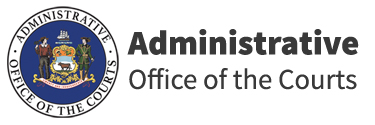Leonard L. Williams Justice Center
Artwork: Floating Forms

Bob Goodnough
"Floating Forms"
"Floating Forms" Sculpture Arrives at Courthouse
A visual feast of brilliant color awaits visitors to the Leonard L. Williams Justice Center in Wilmington, DE when a landmark sculpture by renowned artist Bob Goodnough will be formally dedicated on November 10th. Named by Time Magazine one of the 100 best artists in America, Goodnough has crafted one of the most striking pieces of his distinguished career for the Courthouse Atrium space. "Floating Forms" consists of three large panels, fifteen by nine feet each of brightly colored metal shapes that are designed to project at varying distances from the wall. "My intention here," says the artist, "was to create a work that will uplift the spirit of those who see it."
The intent of the artist harmonizes perfectly with the mission of the Art Committee for the Leonard L. Williams Justice Center. "We want everyone who enters the Courthouse to be inspired by the work of outstanding artists," says Committee Chair Charles F. Richards, Jr. Esq. "We believe that great public spaces deserve great art." The Committee was formed more than two years ago at the behest of former Chief Justice Norman E. Veasey to bring important works of art to the county's newest public building. A unique partnership between the legal community, volunteers and public and private supporters of the arts, the Committee has commissioned two world-class sculptures, including "Floating Forms". A second commission, an obelisk by artist Brower Hatcher will be installed in the Courthouse Plaza in the summer of 2006. Buoyant and colorful, the "Floating Forms" triptych fills one of the atrium walls in the Courthouse.
For Goodnough, this piece is both an innovation and a natural thematic progression in his work. His original inspiration occurred decades ago when, as an art student, he visited the Museum of Natural History in New York. "I was much impressed with the dinosaurs there and the forms remained with me and influenced much of my work, becoming more and more abstract and geometrical. The forms became separated and while relating to each other, more isolated." He has explored these themes in various large paintings as well as silk-screens and sculptures. In "Floating Forms" he takes his exploration a step further by coloring his pieces brightly and adding dimensionality by placing them at varying distances from the wall. The result is a kinetic expression that reflects with the light across every building surface and fills the space with the illusion o dancing shapes.
For Selection Committee Chair Carol Balick, it is a real coup to have such a significant piece from such an important artist at the Leonard L. Williams Justice Center. "This is an absolutely stunning and exciting piece," says Committee member Stuart B. Young, "I have admired Bob Goodnough's work for many years and I'm thrilled to have this piece here in Delaware."
While he is best known as a painter and sculptor, Goodnough is nothing if not versatile. Celebrated for his work in collage and printmaking as well as painting and sculpture, Goodnough has exhibited extensively. His work is in virtually every major museum, including MoMA, the Whitney and the Metropolitan Museum of Art. Known for not attending his own openings, Goodnough is nonetheless considered one of the most accomplished artists of the Second Generation of the New York School, which included such luminaries as Jackson Pollock, Robert Motherwell and Willem de Kooning. One of his paintings was on the living room set of the movie "Who's Afraid of Virginia Woolf" as playwright Edward Albee is both a fan and a collector of Goodnough's work. He has received numerous awards for his work, including a Ford Foundation Prize and a Guggenheim Fellowship. His work was chosen to be in the "Gift to the Nation" Collection, Friends of Art and Preservation in Embassies and the Venice Biennale. Most recently Goodnough received an award in 2005 at the National Academy Museum in New York for his painting "Breakthrough."
Return to Leonard L. Williams Justice Center Art page

